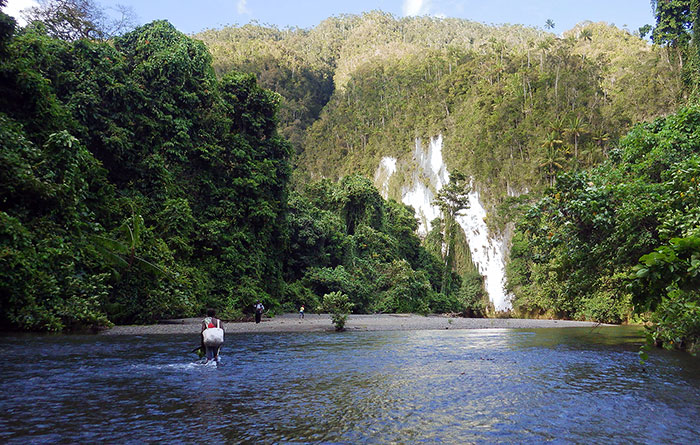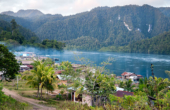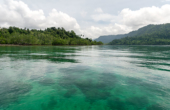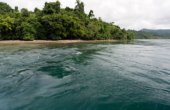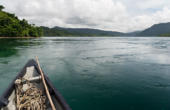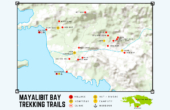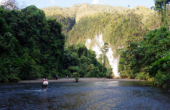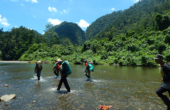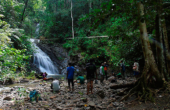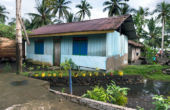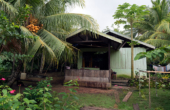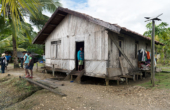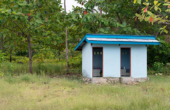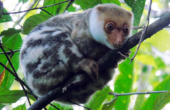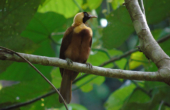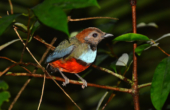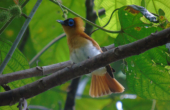- Trips start and end in Waisai
- Pickups can be arranged from some homestays
- Trek lengths: From 2 days/1 night to 5 days/4 nights
- Maximum distance per day: 10km (5 to 7 hours walking)
- Fitness level required: Moderate (high humidity/rough terrain)
- Accommodation: Homestay, jungle hut, or bivouac (sometimes sleeping on wooden floors)
- Price: Depends on group size and trek length.
- Maximum group size: 6 people
Raja Ampat trekking routes
These Raja Ampat trekking routes have been developed by the Waifoi and Warimak communities of Waigeo’s Mayalibit Bay, with the support of a number of NGOs.
The treks explore Waigeo’s wildlife-rich tropical rainforest and the hills and river valleys near the villages of Waifoi and Warimak, which lie on the eastern shore of northern Mayalibit Bay. You’ll get to experience the remote village life of the Ambel Maya people and (on some treks) visit their ancient cultural sites. The Maya are the original inhabitants and traditional owners of Waigeo and many of the surrounding islands, and are the people from whom Mayalibit Bay takes its name.
Waigeo has been famous for its terrestrial biodiversity since Alfred Wallace made the first serious attempt at cataloguing it in 1860. Raja Ampat jungle trekking provides the chance to see many rare birds, animals and plants, many of which are endemic to Waigeo.
You will fall asleep to the nocturnal serenade of the deep Waigeo jungle. You’ll be welcomed in seldom-visited villages and experience traditional Maya village life. You will be immersed in a culture which is markedly different to that of the Biak peoples who inhabit Raja Ampat’s coastal villages.
The boat journey from Waisai to the northern reaches of Mayalibit Bay passes through some utterly spectacular scenery and, if you’re lucky, you may encounter the unique white dolphins that inhabit the bay. If you’re really lucky, you may even get to lay eyes on one of the many crocodiles that frequent the Bay’s dark waters.
Another highlight of the trek packages is a side trip up a small river that winds through the mangrove forests that line Mayalibit’s shores. Where the river meets the land, you can explore a traditional village farm, see how the staple island food of sago is harvested and get to taste fresh cacao. If you’d like to see the mangrove forest’s nocturnal animals (and increase your chances of seeing crocodiles) the mangrove forest inclusion can also be arranged as a night trip.
Your Raja Ampat trekking guides are birding specialists with extensive knowledge of local fauna, flora and cultural sites.
Your participation in the Raja Ampat trekking program will make a huge difference to the lives of the remote Mayalibit Bay communities and will both inspire and empower them to further their role as conservators of Waigeo’s rich jungle habitats.
Read on for/click the link to jump to more information and photos about:
- Raja Ampat trekking requirements
- Raja Ampat trekking prices
- Raja Ampat trekking itineraries
- Homestay pickup/dropoff prices
- Bookings and enquiries
- Raja Ampat trekking accommodation details
- Waigeo’s birds, animals and plants
3 day/2night Waifoi/Warimak trekking trip photos
…and thanks to Katrin and Mark for this short film of their experience :)
Trekking requirements
Fitness
Treks are at an easy pace to allow for all ages and most fitness levels, but they are not recommended for those with a low level of physical fitness. The trekking routes include some sections of steep and rough terrain of medium-high difficulty. Stream and small river crossings are also encountered. Conditions are always warm and very humid and, on clear days, it can be very hot on trail sections exposed to sun.
Footwear
Sturdy footwear is a must to protect against tripping hazards, foot injuries on rough and rocky ground, and splinters from tree roots and forest debris that is often underfoot. When choosing footwear, bear in mind that you’ll need to walk through water occasionally.
Clothing
Lightweight clothing that dries quickly is best. (Even if the weather is fine, it’s virtually guaranteed that you’ll be freely perspiring!) Only carry the minimum you consider essential for your trek length. A hat is a must for sun protection, and a lightweight but sturdy poncho is recommended in case of rain. Anyone from a temperate climate is unlikely to need anything warm, even at night.
Other
Before departing Waisai, trip participants must produce the permit card that proves payment of the Tariff to Support Environmental Services in Raja Ampat.
Sunscreen, insect repellent and a headtorch or flashlight are highly recommended.
You may want to consider bringing a sleeping mat: Mosquito nets are supplied, but mattresses are unavailable at the forest camps and you will be sleeping on wooden floorboards.
Raja Ampat trekking prices
Contact Wolter for prices.
Trips must be paid for prior to departure from Waisai.
You can pay by Paypal or bank transfer prior to arriving in Raja Ampat, or by cash or credit card in Waisai. Be sure to check that your credit card will work in Indonesia before relying on it.
All trek prices include:
- Return boat transport Waisai-Mayalibit Bay-Waisai (~130km)
- Food and accommodation
- Drinking water (bring your own reusable bottle)
- Payments to guides
- Village community fund payments
Prices do not include the Tariff to Support Environmental Services in Raja Ampat that all visitors to Raja Ampat must pay. Be sure to purchase your permit before meeting your guides in Waisai.
Raja Ampat trekking itineraries
You are free to design your own itinerary of any length, but here are 6 suggested routes.
2 day/1 night treks include between 3 and 5 hours’ walking per day, with a maximum distance per day of about 5km.
5 day/ 4 night treks require between 5 and 7 hours’ walking per day and cover a maximum distance of 10km per day.
Suggested trek itinerary details can be viewed here. (PDF: 868KB)
Trekking map and photo gallery
Raja Ampat trekking bookings & enquiries
For bookings, prepayments, and any questions not answered on this page, please contact Wolter (Otter) Gaman.
Otter’s contact details are:
Phone +6281254357477
WA: +6281288863768
Email: woltergaman9@gmail.com
If you have trouble contacting Wolter, the Raja Ampat Homestay Information Center will be able to help.
Trekking accommodation details
Conservation tourism in Warimak and Waifoi villages began in 2016 with the development of trekking routes to several tourist destinations near Warimak village. The Warimak routes were based on old logging trails from the 1990s and were extended into untouched areas that include hills from which panoramic views are available, river valleys and cultural sites.
In Warimak and Waifoi villages, trekkers are accommodated in family homes. You will usually have a room to yourself and mattresses and mosquito nets are supplied. Most village homes do not have their own toilets though. There will be a public toilet building somewhere nearby.
Accommodation while trekking is either at homestay style huts, or in bivouacs. Mosquito nets are supplied, but mattresses are unavailable at the forest camps, so you will be sleeping on wooden floorboards unless you bring a mat.
Kamtabai Forest Hut
Built by Wolter Gaman (who is known as Otter to his friends), Kamtabai Forest Hut is located at Otter’s family gardens, about a 2km walk from Warimak. Kamtabai has a large 3 room hut with a verandah that has table and bench seating. There is also a dining room, a great circular shelter with bench seating surrounding a table, and an outdoor seating area around a firepit. A 2 room bathroom shelter has bucket bathing and a squat toilet.
The garden at Kamtabai provides fresh banana, papaya, sweet potato, sugarcane, jackfruit, rambutan, taro, cacao and coconut. If you want, you can also hunt Balobe (a local freshwater shrimp) in the nearby river.
Attractions near Kamtabai Forest Hut include a waterfall, Red Bird of Paradise display trees, Western Crowned Pigeon habitat and sago harvesting sites. The surrounding forest is full of birds during the day, and full of fireflies at night.
Laen Sorongga Hut
Laen Sorongga Hut was originally a shelter built by Yeheskiel Dawa’s family to provide them with accommodation while working in their food gardens. The family has since converted the hut as part of Warimak’s eco-tourism trekking venture.
Laen Sorongga provides four rooms, a dining shelter, and basic bathroom facilities.
Kanyum and Pindo forest and river camps
Kanyum and Pindo are bivouac style camps that provide basic shelters for sleeping and dining and have pit toilet facilities. Built specifically for trekkers, they were established by Warimak villagers with help from Fauna & Flora International (FFI).
Homestay and trekking camps photo gallery
Waigeo’s fauna and flora
Waigeo is unique among the Raja Ampat islands due to its range of habitats. A mix of weathered volcanic mountains, karst hills, metamorphic hills, and alluvial plains built by river sedimentation create a wealth of ecosystems and microclimates.
Waigeo has a “very wet” climate according to the Schmidt Ferguson classification. Between 2003 and 2016, average rainfall was 254mm per month. Most rain falls between May and July, which typically receive about 339mm per month. September is the driest month with an average of 129mm.
Biogeographically, Waigeo is part of the Sahul Shelf. In the past, Waigeo was joined to the Australian continent and subsequently is home to many animals that share ancestry with their Australian counterparts.
70% of Waigeo’s 3000 square kilometre area lies in protected areas managed by The Natural Resources Conservation Agency of West Papua. The conservation areas are dominated by forested hills over a volcanic rock substrate, but also include alluvial plains and karst hill areas.
Waigeo’s highest point is Danai Mountain at 978m, and primary forests cover 80% of its area. A further 9% is secondary forest. These lowland forests are dominated by big trees with an average diameter of 44 cm and height of 25-30m. FFI’s 2016 biodiversity survey found Vatica rassak to be the most common species, followed by other forest trees such as Teijsmanniodendron bogoriense, matoa (Pometia pinnata), pimelodendron amboinicum and palaquium lobbianum.
Waigeo fauna & flora photos
Birds
FFI’s 2013 and 2016 biodiversity surveys indicate that Waigeo is home to 210 bird species, which represents 31% of all known bird species in Papua. The most sought after by birders are probably the Wilson’s (Cicinnurus respublica) and the Red (Paradisaea rubra) Birds of Paradise, but many other rare and endangered species can also be observed.
Of the 210 bird species recorded in Waigeo, 13 are endemic to Indonesia and 27 are migratory. 174 of the 210 are protected under Indonesian law, 32 species are listed in the CITES appendix, and 12 species are classified by the IUCN as endangered.
A full list of the species that may be seen during a Waigeo forest trek can be viewed here. (PDF: 86KB)
If birding is your specific field of interest, you may also be interested in reading this comprehensive Raja Ampat birding report.
Reptiles & Amphibians
Biodiversity surveys have catalogued 42 species of reptile and 28 species of amphibian on Waigeo. The largest of Waigeo’s terrestrial reptiles are the pythons and monitors.
Pythons you might be fortunate enough to see on a Waigeo forest trek include D’Albertis’ Python (Bothrochilus albertisii), Papuan Olive Python (Liasis papuano), Green Tree Python (Morelia viridis) and the Amethystine or Scrub Python (Simalia amethistina).
Monitors that live on Waigeo and may be encountered on treks include Waigeo’s endemic Golden Speckled Tree Monitor (Varanus boehmei), the Blue-tailed Monitor (Varanus doreanus), and the Peach-throated Monitor (Varanus jobiensis).
Fourteen of Waigeo’s reptile species are classified as endangered by IUCN and the CITES appendix, and are protected by Indonesian law.
Mammals and Marsupials
23 species of mammal and marsupial were logged by the 2016 FFI-IP biodiversity survey.
The Waigeo Spotted Cuscus (Spilocuscus papuensis) is endemic to Waigeo and is almost certain to be seen at night during a trek. The Grey Cuscus (Phalanger orientalis) may also be observed.
Waigeo is also home to nine bat species. Beaufort’s Naked-backed Fruit Bat (Dobsonia beauforti) and the Round-eared Tube-nosed Fruit Bat (Nyctimene cyclotis) are two notable species that you may encounter.
Other animals encountered in the 2016 survey that you may also see include:
Long-nosed spiny bandicoot (Echymipera rufescens)
Long-tailed pygmy possum (Cercartetus caudatus)
Striped possum (Dactylopsila trivirgata)
Sugar glider (Petaurus breviceps)
Himalayan field rat (Rattus nitidus)
Mosaic-tailed rats of the Melomys genus
Flora
Waigeo’s botanical biodiversity rivals that of Raja Ampat’s famed marine environment, and is worthy of the same protections, especially as the Waigeo forests may prove to hold an invaluable pharmacopeia.
An indication of this potential is the discovery that a compound extracted from the bark of the dominant forest tree (Vatica rassak) will inhibit the growth of human colon cancer cells.
There are over 150 species of woody plants alone in Waigeo’s forests. In addition to those, there are 3 species of pitcher plants and 57 species of orchid, most of which are endemic to Waigeo.
Notable species include:
Orchids
Agrostophyllum majus
Coelogyne asperata
Dendrobium antennatum
Dendrobium azureum**
Dendrobium mirbelianum
Grammatophyllum scriptum
Paphiopedilum praestans
Vanda lissochiloides
Pitcher plants
Nepenthes danseri**
Trees
Alstonia beatricis**
Calophyllum parvifolium
Hopea novoguineensis
(** Waigeo endemics)
